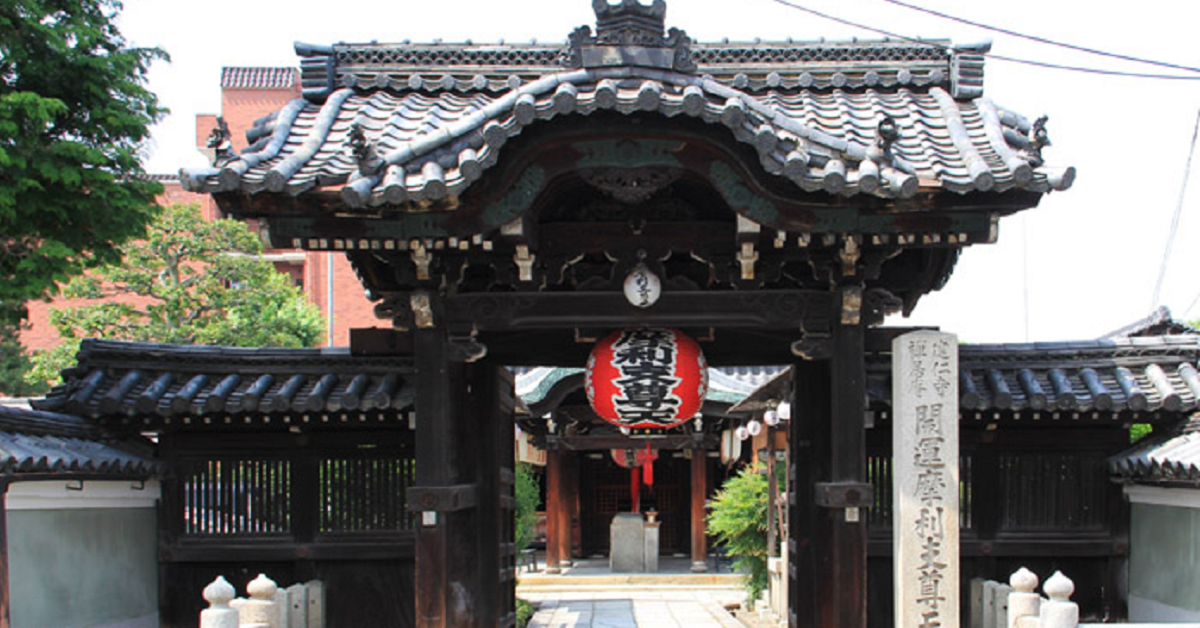Located in Higashiyama, Kyoto, Zenkyoan Marishitendō (禅居庵 摩利支天堂, ぜんきょあん まりしてんどう) is a temple deeply tied to Inosuke Hashibira’s iconic boar head from Demon Slayer. Worshippers believe that Marishiten, the goddess riding wild boars, grants victory, protection, and courage, making this temple a spiritual and cultural landmark.
History and Background of Zenkyoan Marishitendō
Marishitendō belongs to Zenkyoan, a sub-temple of Kenninji, one of the major Zen temples in Kyoto. Kenninji is the head temple of the Rinzai sect and is central to Zen culture in Japan. Within its grounds, Marishitendō has long been a place of faith.
Marishiten originates from Sanskrit, meaning “light.” She was introduced to Japan via China and became known as a goddess of light, war, and protection. In Japan, she was especially worshipped among the samurai class as a protector of victory in battle. Her iconic form is a goddess riding seven wild boars, representing bravery, breakthrough power, and spiritual protection.
During the Warring States period, many warlords prayed to Marishiten for success in battle. For common people, she symbolized protection from misfortune and family safety. Over centuries, her worship became embedded in Kyoto’s spiritual culture.
In modern times, her symbolic connection to Inosuke Hashibira’s boar head has made the temple a sacred site for Demon Slayer fans.
The Connection Between Boars and Inosuke
Boars symbolize bravery, protection, and forward momentum in Marishiten’s faith. Similarly, Inosuke Hashibira, who wears a boar head and lives by the motto “Charge Forward Like a Boar”, embodies the same qualities.
Shared Symbolism of Boars and Inosuke
| Aspect | Marishiten | Inosuke Hashibira |
|---|---|---|
| Sacred Animal | Boar | Wears a boar head |
| Trait | Bravery, protection | Chototsu Mōshin (Charge Forward) |
| Benefit | Victory, warding off evil, fortune | Strength, action, breakthrough power |
This overlap of symbolism makes Zenkyoan Marishitendō especially meaningful to fans. In addition, the boar is part of the Chinese Zodiac, giving it further spiritual significance. People born in the Year of the Boar also visit, seeing the deity as their guardian.
Blessings of Marishitendō
The blessings associated with Zenkyoan Marishitendō are traditionally divided into three main categories: victory, protection from misfortune, and good fortune.
- Victory
Just as samurai prayed for success in battle, modern-day students and athletes visit the temple before important exams or competitions. - Protection from Misfortune
Boars are believed to ward off evil. People in their unlucky years (yakudoshi) often pray here for protection. - Good Fortune
Businesspeople and those starting new ventures seek blessings to open new paths and attract success.
List of Blessings
| Blessing | Meaning | Who It Helps |
|---|---|---|
| Victory | Strength to succeed in challenges | Students, athletes |
| Protection | Warding off misfortune and evil | People in unlucky years, challengers |
| Good Fortune | Attracting luck and opportunities | Entrepreneurs, job seekers |
The concept of “Charge Forward Like a Boar” may sound reckless, but spiritually, it means “the power to break through difficulties.” This is why so many visitors resonate with Marishitendō’s blessings.
Highlights of Visiting Marishitendō
Despite its compact grounds, Zenkyoan Marishitendō is full of highlights.
- Boar Statues
Scattered throughout the temple are statues of boars. Touching their noses is said to bring health, while patting their heads is believed to bring academic success. - Main Hall
At the heart of the temple is the main hall, enshrining Marishiten riding seven boars. The serene yet powerful atmosphere inspires courage in visitors. - Ema and Charms
Wooden plaques (ema) and charms featuring boar motifs are especially popular. Many Demon Slayer fans buy them, writing wishes for strength like Inosuke.
Spots and Their Benefits
| Spot | Feature | Blessing |
|---|---|---|
| Boar Statues | Touch nose or head | Health, academic success |
| Main Hall | Marishiten riding boars | Victory, courage |
| Ema & Charms | Boar designs | Wish fulfillment |
One of the most popular activities is taking photos with the boar statues, often in Inosuke’s iconic pose, and sharing them on social media.
Access and Visiting Tips
Zenkyoan Marishitendō is located in Higashiyama, Kyoto, within the grounds of Kenninji.
- Nearest Stations
Keihan Gion-Shijo Station: ~10 minutes on foot
Keihan Kiyomizu-Gojo Station: ~12 minutes on foot - Nearby Attractions
Kenninji, Kiyomizudera, Yasaka Shrine, and the Gion district - Best Time to Visit
Morning visits are recommended for a quieter atmosphere. During peak tourist seasons, crowds can be heavy, so arriving early is ideal.
Access and Surroundings
| Item | Details |
|---|---|
| Location | Higashiyama, Kyoto |
| Nearest Stations | Gion-Shijo, Kiyomizu-Gojo |
| Nearby Spots | Kenninji, Kiyomizudera, Yasaka Shrine, Gion |
| Recommended Time | Morning |
Conclusion
Zenkyoan Marishitendō (禅居庵 摩利支天堂, ぜんきょあん まりしてんどう) is not only a historic temple of boar worship but also a sacred site for Demon Slayer fans due to its connection with Inosuke Hashibira’s boar head. For centuries, it has been revered as a place of blessings for victory, protection, and fortune.
Touching the boar statues, praying in front of Marishiten, or writing wishes on ema is more than a ritual—it is a way of experiencing Inosuke’s spirit of “Charge Forward Like a Boar.”
When visiting Kyoto, stopping by Zenkyoan Marishitendō allows you to feel the strength of the boar deity and take home courage for your own challenges.






